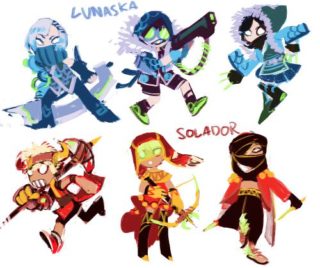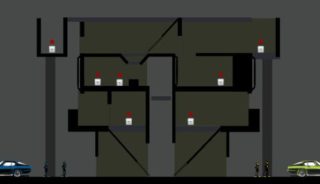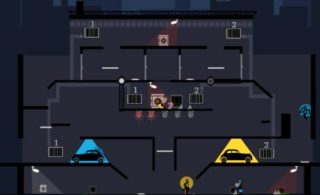As designers, we often sit down to work on a new game with a (so we think) clear idea of what we want the end product to be, or at least a set of core design goals we’d like to reach. Over the course of creating our masters thesis, my team and I learned to let go of our ideas and let our game organically become what it wanted to be, rather than trying to force it to be something it couldn’t.
- Innovative mechanics. Not just platforming and one-hit kills.
- A deep narrative world. The initial concept was about post-apocalyptic civilizations at war for the limited resources remaining in floating islands in the clouds. They were at pointless perpetual war, and we wanted to get across that idea by having ways to succeed other than fighting.
- Permadeath for characters. We wanted unique characters with traits/names/stats that players cared about and would want to keep alive, also supporting non-combative strategies.
- Legacy mechanics. We wanted each round to affect the next in a meaningful way. Player choices would matter and change the world they played in and what options were available to them.

Too Many Ideas
In September, I decided to join their team because all of that sounded pretty cool, plus I’d decided I didn’t want to work alone. We started off by researching (i.e. playing) a lot of other games of all types and making some very basic prototypes. But we had so many different ideas, nothing came together.

Nobody had any idea what our game was about other than being a multiplayer platformer where you shoot and attack people. We got the idea of controlling multiple characters on one team by playing Killer Queen and rotating between characters every time we died, and that was about the only good thing to come from this early phase. But because the switch was on a timer at this point, and our UI sucked, people got confused as to what was happening. Players also had to leave their characters in either a ranged overwatch, melee overwatch, or defensive state before the switch, and that made it even more confusing.

From Scratch Again
We still only had a rudimentary prototype after our first semester, and were feeling disheartened about the whole thing. Having done absolutely nothing during our one-month winter break, we came back in February and all agreed that something needed to change. So in classic Miyamoto fashion we upended our standing desks and decided to start over with a completely new theme.


We sat there spitballing ideas. Dinosaurs? No. Pirates? No (although now that I think about it this could totally work). Space Egyptians? NO! Noir…? 1930s gangsters? Wait what if instead of mining asteroid shards for energy, you were opening safes and stealing money? And money is the resource? Oh that makes sense. Oh and the noir art style can be very minimalist and therefore in scope. Alright, let’s do this!
Suddenly, everything started coming together. People understood what the hell our game was about - now that they were gangsters in a building with a bunch safes and a getaway car, it wasn’t hard to figure out.
Feeling much more motivated, we continued through the spring working 3-4 times as hard as we had in the first semester. At one point so many people were suggesting that our 2-player game should have 4 players that we decided to try it out, and people absolutely loved it. Instead of coordinating the two gangsters themselves, they could do it with a friend! Some people still enjoyed the intensity of the split attention and planning you need in the 1v1 mode, but we’ve found that the game is most accessible as a 4-player party game. But the possibility of having both experiences in one game just makes it better.


4: More Fun Than 2
We continued playtesting and iterating over different mechanics, some of which we kept (vents to move money around, switches to reach new areas) and others we let go (security cameras and sneaking, ladders).
Everything that ended up working well supported the players having to coordinate the two characters, whether they were being controlled by one or two people. All the things that didn’t work were the ones slowing the game down.
We decided against unique character traits (other than the random names), but ended up finding our round-to-round changes through our upgrade system. The choice of what to purchase, or whether to purchase anything at all, adds a real level of depth that you don’t see in other purely reaction-based local multiplayer games like Towerfall or Samurai Gunn.

By the middle of May when we had our big end-of-year show, the game was actually fun to play. A lot of fun. And we realized that nothing mattered other than seeing real people laugh, yell at each other, or even get frustrated while playing, even if we got nowhere near most of our original design goals.
Strip Away Anything But The Core
Ideas are cheap. Being a good game designer means not just executing on those ideas but iterating and iterating to strip away everything but the core of what makes your game work, whether you want players to have fun, think more deeply about the world, or anything in between.

You have to be willing to let your game go down a completely different road than the one you set out on. Even if you want your baby to grow up to be a doctor (maybe we wanted ours to be both a doctor and a lawyer), no matter how hard you push, sometimes they’re going to run off and join the circus. Or at least become a marine biologist. And that’s ok.

In the end, we all graduated and had to get jobs, so couldn’t continue working on 3 Nights in Chicago endlessly, although there’s so much more we’d like to do. For now, you can purchase the game for PC or Mac from our itch.io page for $5. We’re still showing the game at events, and were nominated for best multiplayer at Indie Prize USA 2016. Hopefully we’ll be accepted to IndieCade!
Comments









